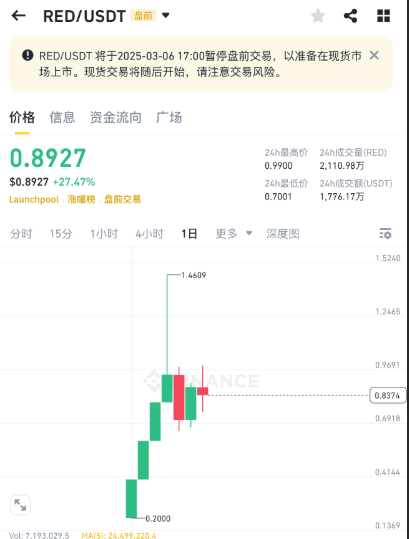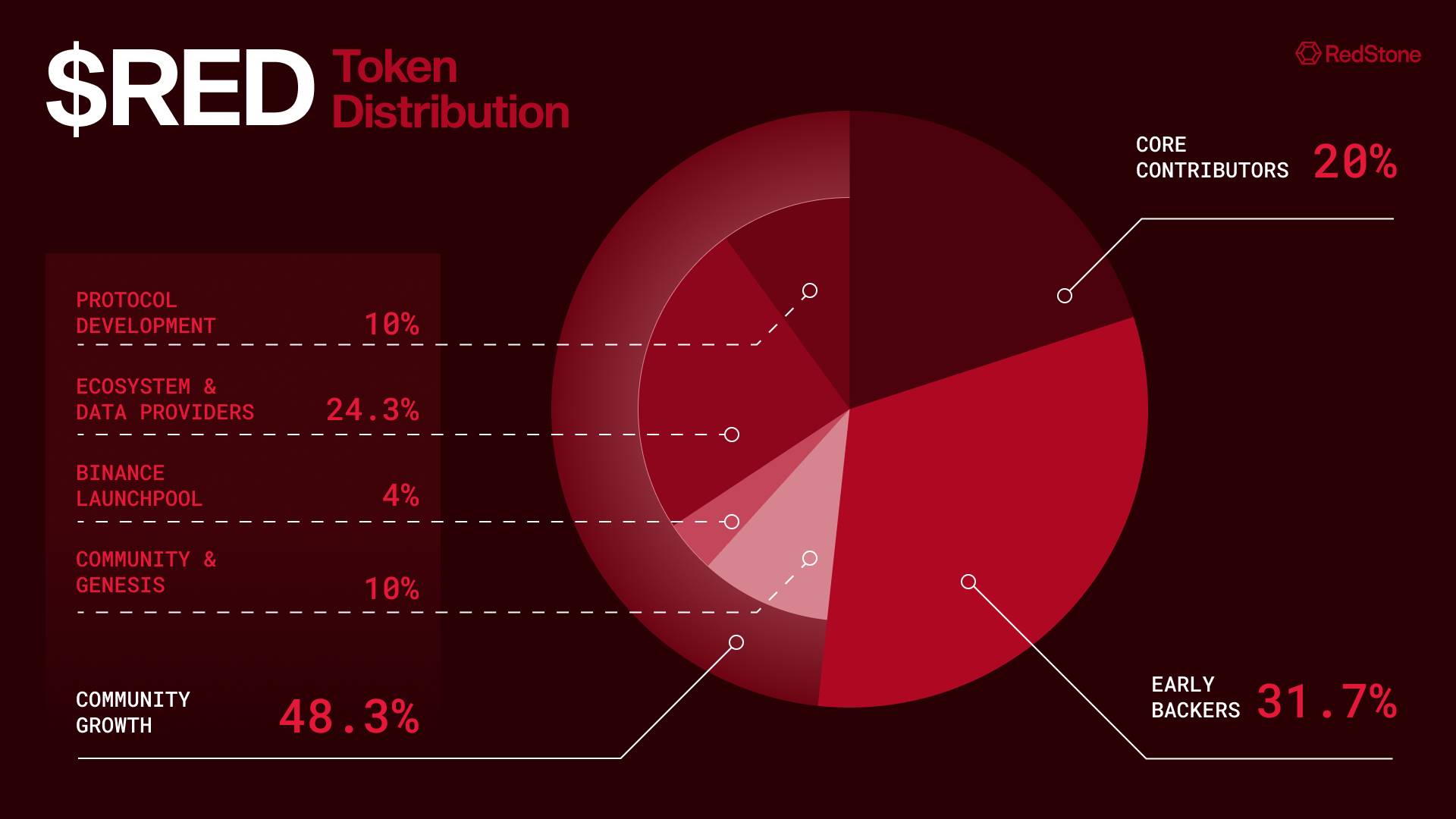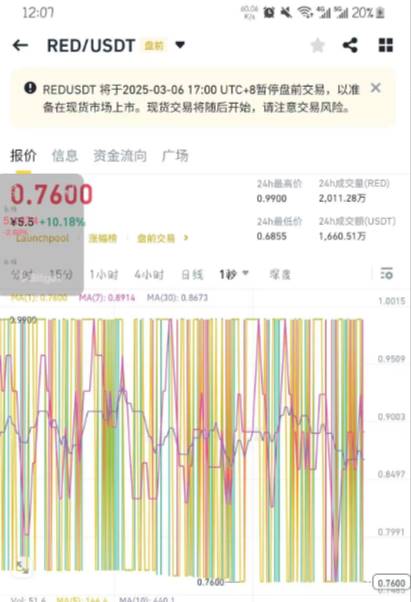A clash of red and black, a test of community trust and market rules.

“Red and black are the intertwining of ambition and reality, the collision of desire and coldness.” -- "The Red and the Black"
In the crypto market, the rise and fall of prices is an endless game; the success or failure of a project is more like a battle of trust and doubt.
As depicted in the classic "The Red and the Black," red symbolizes passion and hope, while black represents shadows and crises.
When we turn our attention to the recently launched project RedStone on Binance Launchpool, this contrast of "red and black" is particularly striking:
As a representative of new cross-chain oracles, RedStone previously attracted market attention with its innovative multi-chain architecture and strong investment background (including Coinbase Ventures and Blockchain Capital).
In the past week, this "red stone" became a highlight in a sluggish market, with its token RED showing a positive price performance in the pre-market on Binance.
However, as the heat intensified, recent controversies surrounding airdrops and price fluctuations in the pre-market gradually emerged, causing this "red stone" to become increasingly "blackened" in the eyes of some community members.
A clash of red and black, a test of community trust and market rules.
The Red Stone in the Price Cap Experiment
In the crypto market, innovation is often the key to attracting attention.
The "Price Cap Mechanism" launched by Binance for RedStone (RED) undoubtedly became the biggest highlight of this experiment.
On February 25, 2025, Binance announced it would test this mechanism in the pre-market trading of Launchpool, aiming to control volatility by limiting price increases and avoiding the recent common "Christmas tree" style of extreme fluctuations during the initial token issuance.
Since RED was launched in the pre-market, this mechanism quickly ignited market enthusiasm.
In three consecutive days of trading, RED's price repeatedly hit the upper limit of the price cap, and after the price restrictions were lifted, it soared to $1.4, becoming the focus of the pre-market.
As of now, RED is reported at $0.83, with a market cap of $33 million, and a fully diluted market cap of $830 million. For a project that just launched in a bear market, the initial performance is indeed impressive, giving everyone a sense that "even the price cap can't contain the upward momentum."

If it can make money, people will naturally like it.
The price cap mechanism indeed brought market enthusiasm to RED, but the applicability of this "red" still needs to be tested.
While the continuous price increase attracted a lot of attention, it may also mask potential issues that could ferment within the community.
The Dark Spot in the Airdrop Controversy
The point of entanglement of interests is the airdrop.
In previous activities, RedStone launched three phases of "exploration activities" through Zealy and Discord platforms, requiring community members to complete various tasks, such as studying technical documents, writing analysis articles, creating graphic materials, and even continuously producing content during the Spring Festival holiday.
These tasks were promoted as opportunities to "co-build the ecosystem," with community members earning RSG points by completing tasks, and RedStone promised that these points would be key credentials for future RED token airdrops.
To put it more bluntly, this effort to earn rewards was quite taxing.
According to its tokenomics (RED Tokenomics), RedStone plans to allocate 48.3% of the tokens to the ecosystem and community, with 10% designated for initial community claims, which community players had high hopes for.

However, on March 5, 2025, when RedStone announced the airdrop results, the community's enthusiasm quickly cooled.
The official announcement stated that only 2.19% of community members (a total of 4,386 people) received RED token rewards, while the RSG points of a large number of remaining players were deemed invalid, leaving those who worked hard seemingly with nothing.
It's not about scarcity but inequality; those who worked hard might end up with nothing, but having the right identity could lead to an airdrop.
According to RedStone's official post, identities in Discord became the key to obtaining airdrops. Eligible roles included Vein Master, Deep Miner, Professor, IRL (those who participated in offline events), etc. Public data shows that the proportion of people with these roles in the project's DC group is only 2%.
Therefore, calculating based on the total community size of around 230,000, the number of people who could receive this airdrop is just the aforementioned 4,000+.
Once the airdrop results were announced, dissatisfaction among community members began to spread across various social media.
Some netizens humorously stated that if you didn't receive the RED airdrop, don't worry, because you will never walk alone.

Meanwhile, angrier players began to voice their complaints directly, with some negative posts quickly circulating in both Chinese and English communities, with sharp language and even hostile wording, accusing RedStone of exploiting community users.
As a neutral observer, I cannot verify whether the accusations in these posts are entirely accurate; however, the community's accumulated grievances cannot be ignored, as the story of "water can carry a boat, but it can also capsize it" frequently plays out in the crypto world.
But at its core, the community's anger boils down to "I worked hard but didn't qualify."
Many users, even after accumulating millions of points, were still excluded and regarded as "ineffective labor": the mere 2.19% reward ratio highlights the age-old issue of "airdrop PUA"—where projects guide users to labor through high-intensity tasks before the token launch but fail to fully deliver on their promises.
When the efforts of community members are gradually devalued to the sacrifices of "digital laborers," players within the system naturally feel they are being exploited for free labor to promote the project, only to have the fruits of their labor snatched away by those with more privileged identities.
Price Fluctuations in the Pre-Market
Under the premise that the airdrop has displeased community members, any abnormality in the token price will evidently deepen misunderstandings and distrust.
This afternoon, some community members shared screenshots showing that the price curve of RED in the pre-market exhibited an extremely erratic state, completely unlike a normal price trend.


Subsequently, well-known KOL @_FORAB also discovered similar issues and speculated that there seemed to be problems with RED's market makers, as a large number of orders were canceled, leading to significant price fluctuations.
This situation easily leads people to mistakenly believe that market makers are playing a solo game, manipulating prices back and forth without proportional retail counterparties.
However, Stephen, the community manager for RedStone's Chinese community, later clarified in the comments that the issue was not caused by market makers. The price changes in the pre-market were actually due to the trading rule design that allowed each person to trade only 5,000 RED.

Subsequently, Binance officially responded that the limit order function for RED/USDT experienced a malfunction from 11:39 to 12:09 on March 6, 2025, but the market order function was operating normally, and the platform has completed repairs.
In terms of results, although the issue did not stem from market maker manipulation, the severe price fluctuations in the current unstable sentiment of the RedStone community quickly spread the "manipulation theory" within the community.
Despite RedStone and Binance clarifying the actual reasons for the issue, retail investors in the crypto market often prefer to believe in conspiracy theories rather than technical explanations. This public opinion effect further exacerbated the community's distrust.
Conclusion
With profit at the forefront, the relationship between project parties and the community in the crypto industry is always delicate: they need each other, but sometimes feel they are harming one another.
From its innovative multi-chain architecture to Binance's price cap mechanism, and then to the airdrop controversy and price fluctuations, this project has experienced a high level of market attention in a short time, while also facing a severe test of community trust.
The airdrop results of RedStone left the vast majority of participants disappointed, even leading to accusations of "PUA" style exploitation. This sentiment is highly contagious in the crypto market, especially in an environment where the community is highly sensitive to fairness.
For RedStone, the future challenge lies in how to repair community relations and establish a more transparent and robust mechanism at both the technical and operational levels.
Perhaps, from a broader perspective, this round of crypto projects needs not only technological innovation but also a profound insight into community sentiment and a comprehensive optimization of market rules.
To gain the community is to gain the world.
免责声明:本文章仅代表作者个人观点,不代表本平台的立场和观点。本文章仅供信息分享,不构成对任何人的任何投资建议。用户与作者之间的任何争议,与本平台无关。如网页中刊载的文章或图片涉及侵权,请提供相关的权利证明和身份证明发送邮件到support@aicoin.com,本平台相关工作人员将会进行核查。




